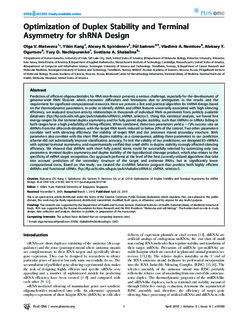| dc.contributor.author | Matveeva, OV | |
| dc.contributor.author | Kang, YB | |
| dc.contributor.author | Spiridonov, AN | |
| dc.contributor.author | Sætrom, Pål | |
| dc.contributor.author | Nemtsov, VA | |
| dc.contributor.author | Ogurtsov, AY | |
| dc.contributor.author | Nechipurenko, YD | |
| dc.contributor.author | Shabalina, SA | |
| dc.date.accessioned | 2015-10-29T13:46:05Z | |
| dc.date.accessioned | 2015-12-10T14:37:17Z | |
| dc.date.available | 2015-10-29T13:46:05Z | |
| dc.date.available | 2015-12-10T14:37:17Z | |
| dc.date.issued | 2010 | |
| dc.identifier.citation | PLoS ONE 2010, 5(4) | nb_NO |
| dc.identifier.issn | 1932-6203 | |
| dc.identifier.uri | http://hdl.handle.net/11250/2367507 | |
| dc.description.abstract | Prediction of efficient oligonucleotides for RNA interference presents a serious challenge, especially for the development of genome-wide RNAi libraries which encounter difficulties and limitations due to ambiguities in the results and the requirement for significant computational resources. Here we present a fast and practical algorithm for shRNA design based on the thermodynamic parameters. In order to identify shRNA and siRNA features universally associated with high silencing efficiency, we analyzed structure-activity relationships in thousands of individual RNAi experiments from publicly available databases (ftp://ftp.ncbi.nlm.nih.gov/pub/shabalin/siRNA/si_shRNA_selector/). Using this statistical analysis, we found free energy ranges for the terminal duplex asymmetry and for fully paired duplex stability, such that shRNAs or siRNAs falling in both ranges have a high probability of being efficient. When combined, these two parameters yield a ∼72% success rate on shRNAs from the siRecords database, with the target RNA levels reduced to below 20% of the control. Two other parameters correlate well with silencing efficiency: the stability of target RNA and the antisense strand secondary structure. Both parameters also correlate with the short RNA duplex stability; as a consequence, adding these parameters to our prediction scheme did not substantially improve classification accuracy. To test the validity of our predictions, we designed 83 shRNAs with optimal terminal asymmetry, and experimentally verified that small shifts in duplex stability strongly affected silencing efficiency. We showed that shRNAs with short fully paired stems could be successfully selected by optimizing only two parameters: terminal duplex asymmetry and duplex stability of the hypothetical cleavage product, which also relates to the specificity of mRNA target recognition. Our approach performs at the level of the best currently utilized algorithms that take into account prediction of the secondary structure of the target and antisense RNAs, but at significantly lower computational costs. Based on this study, we created the si-shRNA Selector program that predicts both highly efficient shRNAs and functional siRNAs (ftp://ftp.ncbi.nlm.nih.gov/pub/shabalin/siRNA/si_shRNA_selector/). | nb_NO |
| dc.language.iso | eng | nb_NO |
| dc.publisher | Public Library of Science | nb_NO |
| dc.title | Optimization of Duplex Stability and Terminal Asymmetry for shRNA Design | nb_NO |
| dc.type | Journal article | nb_NO |
| dc.type | Peer reviewed | en_GB |
| dc.date.updated | 2015-10-29T13:46:05Z | |
| dc.source.volume | 5 | nb_NO |
| dc.source.journal | PLoS ONE | nb_NO |
| dc.source.issue | 4 | nb_NO |
| dc.identifier.doi | 10.1371/journal.pone.0010180 | |
| dc.identifier.cristin | 339893 | |
| dc.description.localcode | This is an open-access article distributed under the terms of the Creative Commons Public Domain declaration which stipulates that, once placed in the public domain, this work may be freely reproduced, distributed, transmitted, modified, built upon, or otherwise used by anyone for any lawful purpose. | nb_NO |
